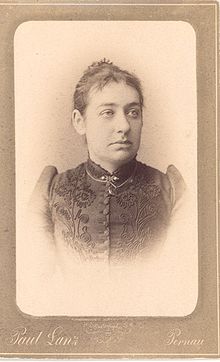Elisabeth Aspe
Elisabeth Aspe (* 3 since 1892 whose real name is Elisabeth Nieländer jul. / 15. December 1860 greg. Saksaküla, then municipality of Sauga , Pärnu county , † 25. August 1927 in Pärnu ) was an Estonian writer .
life and work
Elisabeth Aspe was born the eighth of eleven children of the wealthy entrepreneur Maddis Aspe (1820–1889) and his wife Mari (1822–1888). Her godfather was the Estonian journalist Johann Voldemar Jannsen . From 1871 to 1878 she attended the secondary school for girls in Pärnu. From 1880 she worked with the newspaper Eesti Postimees . In 1881 her debut work as a writer appeared in it, the short story Ene ukse lukutamist . Most of her prose works initially appeared in Estonian newspapers and magazines. In it, she describes the life of Estonians in the past and present in a realistic narrative . Simple farmers and seafarers are just as much a focus as the educated urban upper class.
Among the best-known stories by Elisabeth Aspe are Kasuõde (1887), in which she introduces her ideal of women, the educational novel Ennosaare Ain (1888) about the life of a scientist, and the love story Meremehe mõrsja (1890). In addition, Anna Dorothea (1891) tells of life in Pärnu and Aastate pärast (1911) from the trading community. Elisabeth Aspe has also published numerous short stories, literature for children and memories.
Private life
In 1892 Elisabeth Aspe married Heinrich Nieländer (1845–1903). The couple had two sons and a daughter.
literature
- Cornelius Hasselblatt : History of Estonian Literature. Berlin, New York 2006 ( ISBN 3-11-018025-1 ), pp. 319–323
- Arno Raag: Elisabeth Aspe elu ja looming. Biograafilis-kriitiline essee. Tartu 1928
Web links
Individual evidence
- ↑ Eesti Elulood. Tallinn: Eesti Entsüklopeediakirjastus 2000 (= Eesti Entsüklopeedia 14) ISBN 9985-70-064-3 , p. 28
| personal data | |
|---|---|
| SURNAME | Aspe, Elisabeth |
| ALTERNATIVE NAMES | Nieländer, Elisabeth |
| BRIEF DESCRIPTION | Estonian writer |
| DATE OF BIRTH | December 15, 1860 |
| PLACE OF BIRTH | Saksaküla, then Sauga Municipality , Pärnu County |
| DATE OF DEATH | August 25, 1927 |
| Place of death | Parnu |
